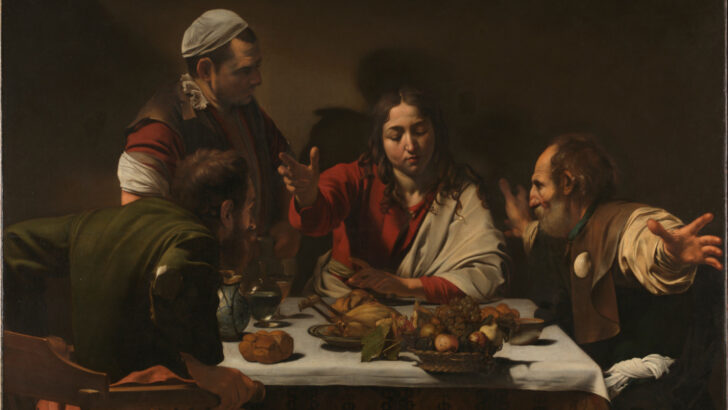An artist who stabbed a man to death is having two of his paintings exhibited at the Ulster Museum in Belfast.
Although no stranger to brawling and prison, powerful connections enabled his notorious behaviour for years; and his talent for producing psychologically complex, deeply spiritual masterpieces helped sustain him.
At present, there is a steady stream of admirers, many of them Catholics, entering the Ulster Museum to marvel at his religious themes and his original use of light and darkness – a technique known as chiaroscuro.
If you have not guessed, the artist is Michelangelo Merisi, a 16th century Italian better known as Caravaggio, who also features on the Listverse website as number ten in a list of artists who were “horrible human beings”.
Yet Caravaggio painted some of the world’s most striking religious art. So, I joined the crowd at the Ulster Museum, for a rare chance to view two of his masterpieces side by side: The taking of Christ and Supper at Emmaus.
Motivation
But this was not my sole motivation. Rather I was soul-searching, grappling with the controversy in the Church over the artwork created by the Slovenian priest Marko Rupnik, who is accused of serious sexual offences against women, mostly religious in the Loyola order he co-founded. Some of the women making the allegations assisted Rupnik in his work.
Naturally, there are deep divisions over what to do about his art which features prominently in the Irish College in Rome as well as major shrines such as Lourdes. Indeed five religious sisters, who claim Rupnik abused them, wrote to 100 Bishops, and others, asking that his work be removed.
Rupnick (69) has already been expelled from the Jesuit order after he refused to cooperate with an internal inquiry (which concluded that the deeply disturbing allegations were “highly credible”).
It’s just been decided that Rupnik’s mosaics at Lourdes Shrine will no longer be illuminated. But the Catholic leader of the Shrine has, so far, stopped short of ordering their removal. Days ago, the Knights of Columbus in the US also decided to cover two sets of Rupnik’s Christian mosaics, pending an investigation.
This comes after the Pope’s safeguarding czar asked Vatican departments not to use Rupnik’s artwork. Cardinal Seán O’Malley, who heads the Pontifical Commission for the Protection of Minors (PCPM), wrote: “Pope Francis has urged us to be sensitive to and walk in solidarity with those harmed by all forms of abuse. I ask you to bear this in mind when choosing images.”
The Cardinal was responding to complaints that Vatican media had continued to use Rupnik’s images despite the allegations. Some maintained that this was not only insensitive but could be seen as sympathy for Rupnik’s case, over the victims.
Does erasing Rupnik’s art ultimately serve the common good? Can we not distinguish between the art and the artist?
This was denied by Paolo Ruffini, the layman who heads the Vatican Dicastery for Communications. He fiercely defended his department’s continued use of Rupnik’s artwork when challenged at a media conference in Atlanta. Ruffini insisted that removing the artwork would not signal any further closeness to victims.
I think Ruffini was wrong. There is no need to keep publishing the artwork, but I am uncomfortable with covering over Rupnik’s mosaics. Although truly repulsed by what he is alleged to have done, I detest the modern cancel culture.
Here’s the thing: Does erasing Rupnik’s art ultimately serve the common good? Can we not distinguish between the art and the artist? Do we have to love the artist to love the art? Are victims truly helped by censorship? And if we only tolerate the art of saintly people how many paintings and sculptures would the Catholic Church have to remove?
Grapple
In life as in art, we must grapple with good and evil. Christ, after all, came for sinners, not the virtuous.
In Matthew 13:29, Jesus himself speaks in his parable of wheat and darnel: the servants were eager to pull up the darnel but were cautioned this might destroy the wheat. “Let them grow together until the harvest,” said the master.
Caravaggio is not alone in his deep human imperfections: the great French painter Paul Gaugin, by 1891, was riddled with syphilis and had infected three child brides younger than 14 in Polynesia. Degas, famed for his beautiful impressionist paintings, was an antisemite. Picasso was a miser who mistreated women, not to mention the darkness in the life of Irish-born Francis Bacon.
God is the ultimate artist, and He alone is perfect.
Knowing the artist’s misdeeds can of course affect how we view the art, whether it is a painter, a songwriter or a filmmaker.
The ugly history of the artist somehow makes the beauty more profound”
But, as I pondered Caravaggio paintings (which will be displayed in Belfast until September 1) I was awestruck by the dramatic scenes from Christ’s life, especially his betrayal, and the breathtaking shift from darkness to light; it was a moving and prayerful experience. The ugly history of the artist somehow makes the beauty more profound, and I am more inclined to pray for his holy soul and those he wounded.
Rupnik is no Caravaggio, but his work was once deemed worthy of Lourdes and other holy places. If Rupnik is found guilty, perhaps a plaque acknowledging the wrong done, and an appeal for prayer for all involved might be preferable to removing the mosaics altogether.


 Martina Purdy
Martina Purdy Caravaggio, The Supper at Emmaus, courtesy the National Gallery London.
Caravaggio, The Supper at Emmaus, courtesy the National Gallery London. 